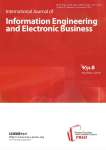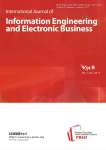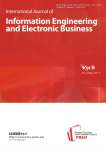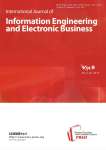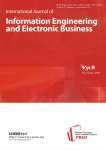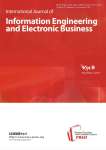- Все статьи 658
-
Подпишитесь, чтобы получать уведомления о публикации новых выпусков
International Journal of Information Engineering and Electronic Business @ijieeb
Статьи журнала - International Journal of Information Engineering and Electronic Business
Все статьи: 658
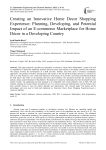
Syed Danish Rizvi, Waqas Mahmood
Статья научная
This paper proposed a possible next-generation e-commerce “Home Décor Marketplace” system with web 3.0 capabilities to disrupt the traditional furniture and home décor retail market in developing countries like Pakistan. This project involves the development of a B2B and B2C furniture and home décor e-commerce marketplace application. The platform will allow manufacturers and retailers to list and sell their products directly to consumers as well as to other businesses. One of the main objectives of the project is to provide a convenient and efficient platform for both buyers and sellers in the furniture and home decor industry. The document describes the research work, analysis, design, and development of the platform. The proposed e-commerce marketplace has been developed based on market research. The application has been designed to be compatible with various platforms such as Web, iOS, and Android, utilizing the Google Flutter development tool. It is secured using user authentication, and the features have been carefully chosen to meet the market demands and requirements. This research paper will discuss all the technologies and tools used to build and implement an Innovative Home Decor Shopping Experience-based e-commerce platform.
Бесплатно
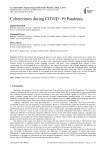
Cybercrimes during COVID -19 Pandemic
Raghad Khweiled, Mahmoud Jazzar, Derar Eleyan
Статья научная
COVID-19 pandemic has changed the lifestyle of all aspects of life. These circumstances have created new patterns in lifestyle that people had to deal with. As such, full and direct dependence on the use of the unsafe Internet network in running all aspects of life. As example, many organizations started officially working through the Internet, students moved to e-education, online shopping increased, and more. These conditions have created a fertile environment for cybercriminals to grow their activity and exploit the pressures that affected human psychology to increase their attack success. The purpose of this paper is to analyze the data collected from global online fraud and cybersecurity service companies to demonstrate on how cybercrimes increased during the COVID-19 epidemic. The significance and value of this research is to highlight by evident on how criminals exploit crisis, and for the need to develop strategies and to enhance user awareness for better detection and prevention of future cybercrimes.
Бесплатно
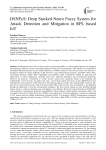
DSNFyS: Deep Stacked Neuro Fuzzy System for Attack Detection and Mitigation in RPL based IoT
Prashant Maurya, Vandana Kushwaha
Статья научная
The Routing Protocol for Low-Power and Lossy Networks (RPL) is a widely adopted protocol for managing and optimizing routing in resource-constrained Internet of Things (IoT) environments. RPL operates by constructing a Destination-Oriented Directed Acyclic Graph (DODAG) to establish efficient routes between nodes. This protocol is designed to address the unique challenges of IoT networks, such as limited energy resources, unreliable wireless links, and frequent topology changes. RPL's adaptability and scalability render it particularly suitable for large-scale IoT deployments in various applications, including smart cities, industrial automation, and environmental monitoring. However, the protocol's vulnerability to various security attacks poses significant threats to the reliability and confidentiality of IoT networks. To address this issue, a novel deep-stacked neuro-fuzzy system (DSNFyS) has been developed for attack detection in RPL-based IoT. The proposed approach begins with simulating RPL routing in IoT, followed by attack detection processing at the Base Station (BS) using log data. Data normalization is accomplished through the application of min-max normalization techniques. The most crucial features are then identified through feature selection, utilizing information gain and Support Vector Machine-Recursive Feature Elimination (SVM-RFE). Attack detection is subsequently performed using DSNFyS, which integrates a Deep Stacked Autoencoder (DSA) with an Adaptive Neuro-Fuzzy Inference System (ANFIS). Upon detection of an attack, mitigation is carried out employing a DSA trained using the Hiking Optimization Algorithm (HOA). The proposed DSNFyS demonstrated exceptional performance, achieving the better accuracy of 97.41%, True Positive Rate (TPR) of 97.60%, and True Negative Rate (TNR) of 97.12%.
Бесплатно
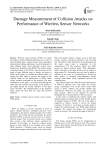
Damage Measurement of Collision Attacks on Performance of Wireless Sensor Networks
Mina Malekzadeh, Sadegh Ebady, M.H. Shahrokh Abadi
Статья научная
Wireless sensor networks (WSN) are widely developed to monitor different phenomena in a variety of areas including nature, medical centers, home automation, industrial and military applications. Such development in many different fields, raises important security issues related to the reliability of the WSNs. Due to the resource constrained nature of the WSNs, these networks are the target of many different types of attacks and prone to failure. In this paper, we consider the collision attack. An attempt has been made to measure the impact of the collision attack on the performance of WSNs under variety scenarios performed by the attackers. The main contribution of this paper is to present that although the attack does not consume much energy of the attacker, it can highly disrupt the normal operation of the target sensor networks. The implementation of the proposed attack model has been done by using NS2 network simulator.
Бесплатно
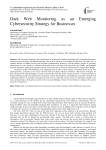
Dark Web Monitoring as an Emerging Cybersecurity Strategy for Businesses
Ashwini Dalvi, Sunil Bhirud
Статья научная
The increasing frequency and sophistication of cyberattacks targeting institutions have necessitated proactive measures to prevent losses and mitigate damages. One of these measures is to monitor the dark web. The dark web is a complex network of hidden services and encrypted communication protocols, with the primary purpose of providing anonymity to its users. However, criminals use the dark web to sell stolen data, launch zero-day attacks, and distribute malware. Therefore, identifying suspicious activity on the dark web is necessary for businesses to counter these threats. An analysis of dark web monitoring as an emerging trend in cyber security strategy is presented in this article. The article presents a systematic review of (a) why dark web surveillance enhances businesses' cybersecurity strategies, (b) how advanced tools and technologies are used to monitor dark web data in the commercial sector, (c) the key features of threat monitoring frameworks proposed by researchers, and (d) the limitations and challenges associated with dark web monitoring solutions. In summary, the proposed work involves analyzing various sources of information related to the topic and presenting a thorough assessment of the need and challenges of dark web surveillance to enhance the security measures of businesses.
Бесплатно
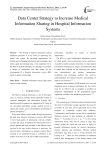
Data Center Strategy to Increase Medical Information Sharing in Hospital Information Systems
Karim Zarour, Nacereddine Zarour
Статья научная
The sharing of medical information among healthcare providers is a key factor in improving any health care system. By providing opportunities for sharing and exchanging information and knowledge, data center, agent and ontology play a very important role in the field of medical informatics. In this paper, we propose a design of architecture and data center for the development of a Hospital information system (HIS) based on agents and ontology.
Бесплатно
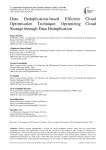
Ranga Kavitha, Mahaboob Sharief Shaik, Narala Swarnalatha, M. Pujitha, Syed Asadullah Hussaini, Samiullah Khan, Shamsher Ali
Статья научная
Effective storage management is crucial for cloud computing systems' speed and cost, given data's exponential increase. The significance of this issue has increased as the amount of data continues to increase at a disturbing pace. The act of detecting and removing duplicate data can enhance storage utilisation and system efficiency. Using less storage capacity reduces data transmission costs and enhances cloud infrastructure scalability. The use of deduplication techniques on a wide scale, on the other hand, presents a number of important obstacles. Security issues, delays in deduplication, and maintaining data integrity are all examples of difficulties that fall under this classification. This paper introduces a revolutionary method called Data Deduplication-based Efficient Cloud Optimisation Technique (DD-ECOT). Optimising storage processes and enhancing performance in cloud-based systems is its intended goal. DD-ECOT combines advanced pattern recognition with chunking to increase storage efficiency at minimal cost. It protects data during deduplication with secure hash-based indexing. Parallel processing and scalable design decrease latency, making it adaptable enough for vast, ever-changing cloud setups.The DD-ECOT system avoids these problems through employing a secure hash-based indexing method to keep data intact and by using parallel processing to speed up deduplication without impacting system performance. Enterprise cloud storage systems, disaster recovery solutions, and large-scale data management environments are some of the usage cases for DD-ECOT. Analysis of simulations shows that the suggested solution outperforms conventional deduplication techniques in terms of storage efficiency, data retrieval speed, and overall system performance. The findings suggest that DD-ECOT has the ability to improve cloud service delivery while cutting operational costs. A simulation reveals that the proposed DD-ECOT framework outperforms existing deduplication methods. DD-ECOT boosts storage efficiency by 92.8% by reducing duplicate data. It reduces latency by 97.2% using parallel processing and sophisticated deduplication. Additionally, secure hash-based indexing methods improve data integrity to 98.1%. Optimized bandwidth usage of 95.7% makes data transfer efficient. These improvements suggest DD-ECOT may save operational costs, optimize storage, and beat current deduplication methods.
Бесплатно
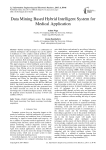
Data Mining Based Hybrid Intelligent System for Medical Application
Adane Nega, Alemu Kumlachew
Статья научная
Hybrid intelligent system is a combination of artificial intelligence (AI) techniques that can be applied in healthcare to solve complex medical problems. Case-based reasoning (CBR) and rule based reasoning (RBR) are the two more popular AI techniques which can be easily combined. Both techniques deal with medical data and domain knowledge in diagnosing patient conditions. This paper proposes a hybrid intelligent system that uses data mining technique as a tool for knowledge acquisition process. Data Mining solves the knowledge acquisition problem of rule based reasoning by supplying extracted knowledge to rule based reasoning system. We use WEKA for model construction and evaluation, Java NetBeans for integrating data mining results with rule based reasoning and Prolog for knowledge representation. To select the best model for disease diagnosis, four experiments were carried out using J48, BFTree, JRIP and PART. The PART classification algorithm is selected as best classification algorithm and the rules generated from the PART classifier are used for the development of knowledge base of hybrid intelligent system. In this study, the proposed system measured an accuracy of 87.5% and usability of 89.2%.
Бесплатно
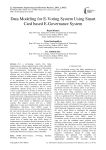
Data Modeling for E-Voting System Using Smart Card based E-Governance System
Rupali Khatun, Tania Bandopadhyay, Abhishek Roy
Статья научная
For a developing country like India, maintaining an efficient administration within affordable budget is a big challenge. The application of Information and Communication Technology (ICT) based E-Governance can facilitate the administration in much efficient and cost effective manner compared to the traditional method of administration. Since an efficient administration is dependent on the collection of opinion of its participants (i.e the voters), flawless voting mechanism becomes the primary pillar of governance. But in the present days of busyness, many people stay away from their voting constituency due to various compulsions, thereby giving rise to number of uncast votes to a significant level. In order to solve this problem, in this paper authors have extended the concept of multifaceted smart card oriented E-Governance system to propose bio-metric authentication based E-Voting system, where Bluetooth fingerprint scanner will be paired with the voter's smart phone to implement the proposed concept. This propose system will use a mobile application to input user identification number using the Multipurpose Electronic Card (MEC) based E-Governance system. In case of successful authentication, the voter will be allowed to caste the original vote, else it will be barred. Hence, this approach will prevent the malicious tendency of proxy voting using advanced authentication system. Since this proposed E-Voting system have to handle huge data traffic during its implementation, its database should be designed at first to reduce data redundancy and inconsistency as much as possible. Hence, in this paper, authors have designed its database system using Data Flow Diagram (DFD), Entity Relationship Diagram (ERD) to demonstrate the relationship between its primary entities and tables.
Бесплатно
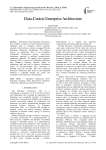
Data-Centric Enterprise Architecture
Zeinab Rajabi, Maryam Nooraei Abade
Статья научная
Enterprises choose Enterprise Architecture (EA) solution, in order to overcome dynamic business challenges and in coordinate various enterprise elements. In this article, a solution is suggested for the Enterprise Architecture development. The solution focuses on architecture data in the Enterprise Architecture development process. Data-centric architecture approach is preferred product-centric architecture approach. We suggest using Enterprise Ontology (EO) as context for collecting architecture data; Enterprise Ontology enhances quality of architecture data and lead to effective architecture results for decision-making. First, Enterprise is modeled using the ontology. Then how collecting Enterprise Architecture data based on the Enterprise Ontology is explained. Finally, the results and advantages of the solution are demonstrated.
Бесплатно
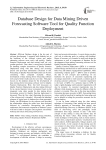
Database Design for Data Mining Driven Forecasting Software Tool for Quality Function Deployment
Shivani K. Purohit, Ashish K. Sharma
Статья научная
Efficient Database design is the key part of software development. A properly built database acts as the backbone of the software system and makes enhancing software more easily and quickly. Quality Function Deployment and data mining itself are very gordian processes. Thus, there is strong need of database for handling complex transactions of Quality Function Deployment along with data mining and accessing precise and up-to-date information concerned to this. Forecasting in Quality Function Deployment can be time consuming when computed manually. Hence, development of data mining driven forecasting software tool can give better results and also save time. This paper focuses on the database design for the development of data mining driven forecasting software tool for Quality Function Deployment. Here, first brief discussion on Quality Function Deployment and data mining followed by its concise literature review is presented. Later on, the integrated value chain needed by data mining driven forecasting system for Quality Function deployment is discussed. Then the flow chart illustrating the processes of the software tool is intended. Afterwards the tabulated schemas of logical part of database have been presented. Finally, the ER-diagram for the software and described the relationships among the tables have been designed followed by conclusion. Recognizing the general architecture and structural component of database system will lend a hand to designers and engineers successfully build up and sustain forecasting software tool.
Бесплатно
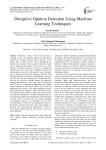
Deceptive Opinion Detection Using Machine Learning Techniques
Naznin Sultana, Sellappan Palaniappan
Статья научная
Nowadays, online reviews have become a valuable resource for customer decision making before purchasing a product. Research shows that most of the people look at online reviews before purchasing any product. So, customers reviews are now become a crucial part of doing business online. Since review can either promote or demote a product or a service, so buying and selling fake reviews turns into a profitable business for some people now a days. In the past few years, deceptive review detection has attracted significant attention from both the industrial organizations and academic communities. However, the issue remains to be a challenging problem due to the lack of labeled dataset for supervised learning and evaluation. Also, study shows that both the state of the art computational approaches and human readers acquire an error rate of about 35% to 48% in identifying fake reviews. This study thoroughly investigated and analyzed customers’ online reviews for deception detection using different supervised machine learning methods and proposes a machine learning model using stochastic gradient descent algorithm for the detection of spam review. To reduce bias and variance, bagging and boosting approach was integrated into the model. Furthermore, to select the most appropriate features in the feature selection step, some rules using regular expression were also generated. Experiments on hotel review dataset demonstrate the effectiveness of the proposed approach.
Бесплатно
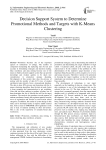
Decision support system to determine promotional methods and targets with k-means clustering
Yazid, Ema Utami
Статья научная
Promotion becomes one of the important aspects of institutions of college. The number of competitors demanding the marketing must be fast and accurate in formulating strategies and decision making. Data warehouse and data mining become one of the means to build a decision support system that can provide knowledge and wisdom quickly to be taken into consideration in promotion strategy planning. Development of this system then does the process of testing with the number of data 6171 rows of student enrollment taken directly from a transactional database. The data is done ETL process and clustering with the k-means clustering algorithm, then the data in each cluster is done grouping and summarization to get weighting. After that just done ranking to produce wisdom, one of them determine the list of schools that will be the target roadshow. The analysis also produces several patterns of student enrollment, namely the registrant pattern from the wave of registration and favorite or non-favorite school categories. In addition, the results of system design in this study can be developed easily if requires added external data. Such as data of SMK/SMK school graduates in the area or data of students enrolling in other universities. This is one of the superiority of semantic-based data warehouses.
Бесплатно
- О проекте
- Правообладателям
- Правила пользования
- Контакты
- Разработчик: ООО "Технологии мобильного чтения"
Государственная аккредитация IT: АО-20230321-12352390637-3 | Минцифры России - 2025 © SciUp.org — Платформа публикаций в области науки, технологий, медицины, образования и литературы. "SciUp" — зарегистрированный товарный знак. Все права защищены.

